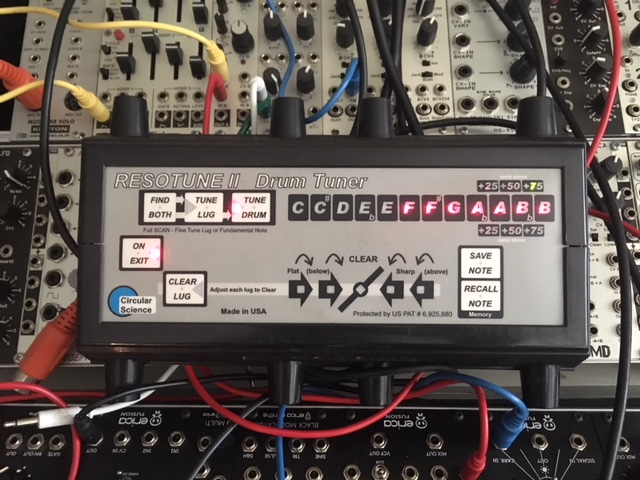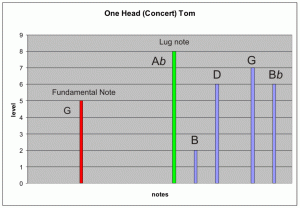You are using an out of date browser. It may not display this or other websites correctly.
You should upgrade or use an alternative browser.
You should upgrade or use an alternative browser.
pitch bend on tom
- Thread starter kambo
- Start date
Help Support GroupDIY Audio Forum:
This site may earn a commission from merchant affiliate
links, including eBay, Amazon, and others.
pucho812
Well-known member
so the hit is thud or whatever and then them the pitch bends up as the tail fades out?
kambo said:i am hearing a pitch bending up effect on tail of tom sound, after the initial hit sound...
whats that mean ? tom needs to be pitched higher?
That can be from the two heads being tuned to different lug resonances...after the initial hit dominated by the batter head the fundamental (both heads) and resonant head make their contributions.
Many people tune (detune heads apart) that way on purpose... do you want it to move in other direction? or not al all... Just voice it how you want it to go.
JR
yespucho812 said:so the hit is thud or whatever and then them the pitch bends up as the tail fades out?
this pitch bend up is happening regardless of two heads.... i hear it on single skin / skin on one side onlyJohnRoberts said:That can be from the two heads being tuned to different lug resonances...after the initial hit dominated by the batter head the fundamental (both heads) and resonant head make their contributions.
Many people tune (detune heads apart) that way on purpose... do you want it to move in other direction? or not al all... Just voice it how you want it to go.
JR
percussions too.
OK concert tom (only one head mounted) obviously does not have interactions between "two" heads.kambo said:this pitch bend up is happening regardless of two heads.... i hear it on single skin / skin on one side only
percussions too.
When you first strike a drum (hard) the head deforms and stretches tighter momentarily expressing a slightly higher pitch. After it relaxes the pitch normalizes lower. This is generally a short term phenomenon.
I have no physical explanation for the symptom you describe (higher pitch after ring).
JR
JohnRoberts said:OK concert tom (only one head mounted) obviously does not have interactions between "two" heads.
When you first strike a drum (hard) the head deforms and stretches tighter momentarily expressing a slightly higher pitch. After it relaxes the pitch normalizes lower. This is generally a short term phenomenon.
I have no physical explanation for the symptom you describe (higher pitch after ring).
JR
hmmm, when it stretches, which is pitch up... right!
when after the strike, head relaxes, so i should be hearing a pitch bend "down" sound... not up ???
Yes but the pitch bend should be small and relax pretty quick... The more common after ring phenomenon is from (two) detuned heads.kambo said:hmmm, when it stretches, which is pitch up... right!
when after the strike, head relaxes, so i should be hearing a pitch bend "down" sound... not up ???
There may be more moving parts (resonances) involved, but I expect head mass and tension to dominate.
JR
JohnRoberts said:Yes but the pitch bend should be small and relax pretty quick... The more common after ring phenomenon is from (two) detuned heads.
There may be more moving parts (resonances) involved, but I expect head mass and tension to dominate.
JR
pitch up is actually coming after couple of hundred milisecs later!
changed mp3 extension to txt to upload...
EDIT: edited the sound, so can hear the pitch bend up clearly.... sorry for the background noise of traffic!
Attachments
I hear a little lug or other mechanical rattle just after the impact ,three metalic clicks in quick sucession , I think some use a small amount of thick grease inside the lug housing just to damp any possible resonances , could be a spring buzzing or a loose mounting screw . Sometime brand new heads just dont sound right , other times if a head wasnt seated nice to begin with it can end up stretching unevenly ,I generally only saw that on snare drums though ,where tension is much higher. You could try a pinstripe , there usually a bit more damped.
Other than that I'd go around the screws inside the shell and make sure there all evenly tightened , Lugs without head ,hoop and bolts often make funny noises too .
heres a classic clip from the movie about Factory records and Martin Hannett ,
https://www.youtube.com/watch?v=zGA6rmsnDkQ
I couldnt help be reminded of it when I saw your question ,
'we've got a rattle ........... where going to have to dismantle the entire fuking drumkit ' ;D
Hannett proceeded to strip every nut and screw on the kit to find the problem ,
Usually its easier just to locate the buzz/ rattle by ear or even moving the mic until your able to localise the problem could save a lot of time.
If your worried about the tail pitching up at the end a damper ring should give more control ,theres also a kind of jello blob you get nowadays ,just sits at the edge of the skin ,there handy as you can apply them just as needed without deadening down timbre too much .
White lithium grease seems to come with a recomendation for doing the lugs , this guy also packs some fibre into the lug to damp the spring , Ive not used that myself ,but it seems like a good tip , especially if there unused .
https://www.youtube.com/watch?v=GNCLmiBAPdU
I see also guys using ptfe washers between hoop and lugbolt , probably makes tuning smoother ,but maybe a little less stable if your kit goes in and out the back of a van all the time .
For a studio kit its very well worth doing the full breakdown once in a while , the little gremlins and rattles can be magnified through micing and leave a mechanical smear on the sound , you could easily spend half a day tuning a typical live drum set up to studio tune , its often beneficial to get the drummer in ahead of the rest as its stupendously boring for the other musicians to wait around for hours and hours .
Other than that I'd go around the screws inside the shell and make sure there all evenly tightened , Lugs without head ,hoop and bolts often make funny noises too .
heres a classic clip from the movie about Factory records and Martin Hannett ,
https://www.youtube.com/watch?v=zGA6rmsnDkQ
I couldnt help be reminded of it when I saw your question ,
'we've got a rattle ........... where going to have to dismantle the entire fuking drumkit ' ;D
Hannett proceeded to strip every nut and screw on the kit to find the problem ,
Usually its easier just to locate the buzz/ rattle by ear or even moving the mic until your able to localise the problem could save a lot of time.
If your worried about the tail pitching up at the end a damper ring should give more control ,theres also a kind of jello blob you get nowadays ,just sits at the edge of the skin ,there handy as you can apply them just as needed without deadening down timbre too much .
White lithium grease seems to come with a recomendation for doing the lugs , this guy also packs some fibre into the lug to damp the spring , Ive not used that myself ,but it seems like a good tip , especially if there unused .
https://www.youtube.com/watch?v=GNCLmiBAPdU
I see also guys using ptfe washers between hoop and lugbolt , probably makes tuning smoother ,but maybe a little less stable if your kit goes in and out the back of a van all the time .
For a studio kit its very well worth doing the full breakdown once in a while , the little gremlins and rattles can be magnified through micing and leave a mechanical smear on the sound , you could easily spend half a day tuning a typical live drum set up to studio tune , its often beneficial to get the drummer in ahead of the rest as its stupendously boring for the other musicians to wait around for hours and hours .
My area of study and work is mainly about drum head resonances and interactions. So this is pure speculation on my part, perhaps a higher shell resonance pitch is pulling the vibrating system higher.kambo said:pitch up is actually coming after couple of hundred milisecs later!
changed mp3 extension to txt to upload...
EDIT: edited the sound, so can hear the pitch bend up clearly.... sorry for the background noise of traffic!
You can experiment with tuning the head higher and seeing how it responds. Maybe tune it higher than the after ring and see if it drops after the hit.
There are some drum makers invested in the significance of shell resonances (like DW).
JR
Again pure speculation but can you add mass to the shell?kambo said:tuning up is helping to keep a steady pitch... but by the time
i reach that point, tom is way too tight to play...
JR
JohnRoberts said:Again pure speculation but can you add mass to the shell?
JR
how do i add mess to tom shell ?
anyway, got the Resotune II out...
did the full scan, find the note... it was C
tuned the tom to B+(slightly over B)
WOLLLAAAAAAA
i have perfect pitch with perfect tail
I don't know (mass?).kambo said:how do i add mess to tom shell ?
Well why didn't you do that first.... :anyway, got the Resotune II out...
did the full scan, find the note... it was C
tuned the tom to B+(slightly over B)
WOLLLAAAAAAA
i have perfect pitch with perfect tail

Don't make me remove you from my website user area....
JR
PS: My apologies to the list for the appearance of blatant self promotion... If you don't play drums, YOU DO NOT NEED A RESOTUNE.
If you used skinny drum sticks (1/2") they would work.kambo said:Q : Well why didn't you do that first....
A: i was looking for the sticks that comes with ;D
JR
PS: At one point I half considered making and selling my own drum sticks, in hindsight I'm glad I didn't
JohnRoberts said:If you used skinny drum sticks (1/2") they would work.
JR
good point.. i realised that after i found the sticks, i was keeping it quiet
boji
Well-known member
I listened to it a few times and it sounds like both pitches are in the recording, but the dominant lower pitch fades out and leaves the higher one as a tail.
Drums make multiple different pitches when struck and where you strike them on the head can excite different resonances preferentially over others. Hitting the head dead center excites the lowest fundamental. Hitting progressively closer to the edge excites higher and higher overtones.boji said:I listened to it a few times and it sounds like both pitches are in the recording, but the dominant lower pitch fades out and leaves the higher one as a tail.

Here is a series of measurements I made on a one head drum and you can see the lug overtone is louder than the fundamental all else equal. Note: this measurement is made by exciting the drumhead with a constant loudness speaker, so not a perfect representation of response to being struck with drumstick.
JR
Similar threads
- Replies
- 1
- Views
- 193
- Replies
- 4
- Views
- 325










![Electronics Soldering Iron Kit, [Upgraded] Soldering Iron 110V 90W LCD Digital Portable Soldering Kit 180-480℃(356-896℉), Welding Tool with ON/OFF Switch, Auto-sleep, Thermostatic Design](https://m.media-amazon.com/images/I/41gRDnlyfJS._SL500_.jpg)





















